Many types of common black moths in the world live in North America. Several other species are found in Europe and the rest of the world.
Asia and Southeast Asia are also regions of the world where black moths live. Some of the largest black moths are further found in Australia, particularly on The East Coast.
Black moths are mostly nocturnal and they might not be easily spotted. They feed on various foods such as tree sap or rotting fruit.
Their caterpillars eat leaves, wildflowers, fungi, and even grasses. Found along woodlands, black moths may be difficult to spot at night due to their dark appearance.
Moths can have a uniform black color or a mottled black appearance. Various types of moth species of various sizes are even moved from one species to another as research evolves in this area.
As with other species of moths, black moths may also be migratory.
The following species of black moths are most likely to be spotted around the world in regions with stable populations. As some of them may stray, they might also be found outside of these areas.
Here are some of the most common black moths of the world and the regions they are found in the highest numbers.
Table of Contents
1. Yellow-collared Scape Moth
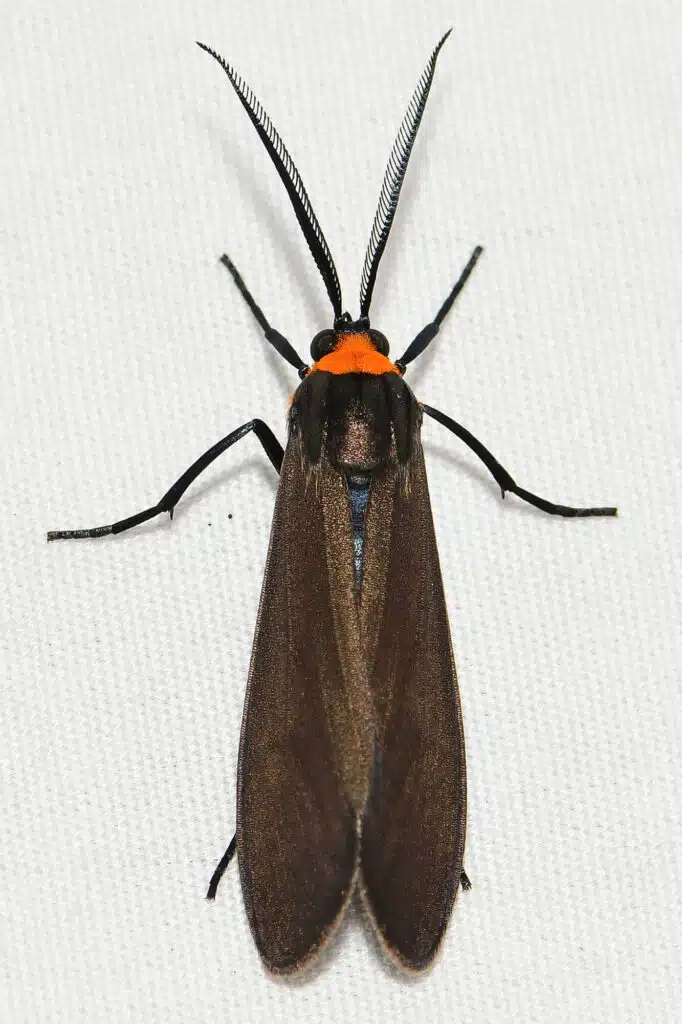
Scientific name: Cisseps fulvicollis
Yellow-collared Scape Moths are one of the largest and most common black moths in North America.
This species has a wide size difference between the sexes. Females can reach a wingspan of over 9 inches while males can reach a maximum wingspan of up to 5 inches.
A mostly black color is typical across its wings. Pink V-shaped bands are further seen on the dark wings of the species.
The Yellow-collared Scape Moth is a species that lives in Southern US states, with strays sometimes migrating up to Canada.
The species is more common in Central and Southern America where popular culture associates it with death based on its color.
Moths of the genus feed on fruits that grow in rainforests and the Southern part of Southern US states. Its caterpillars feed on tree leaves.
Distribution: Sothern US down to Brazil
2. Eight-spotted Forester Moth
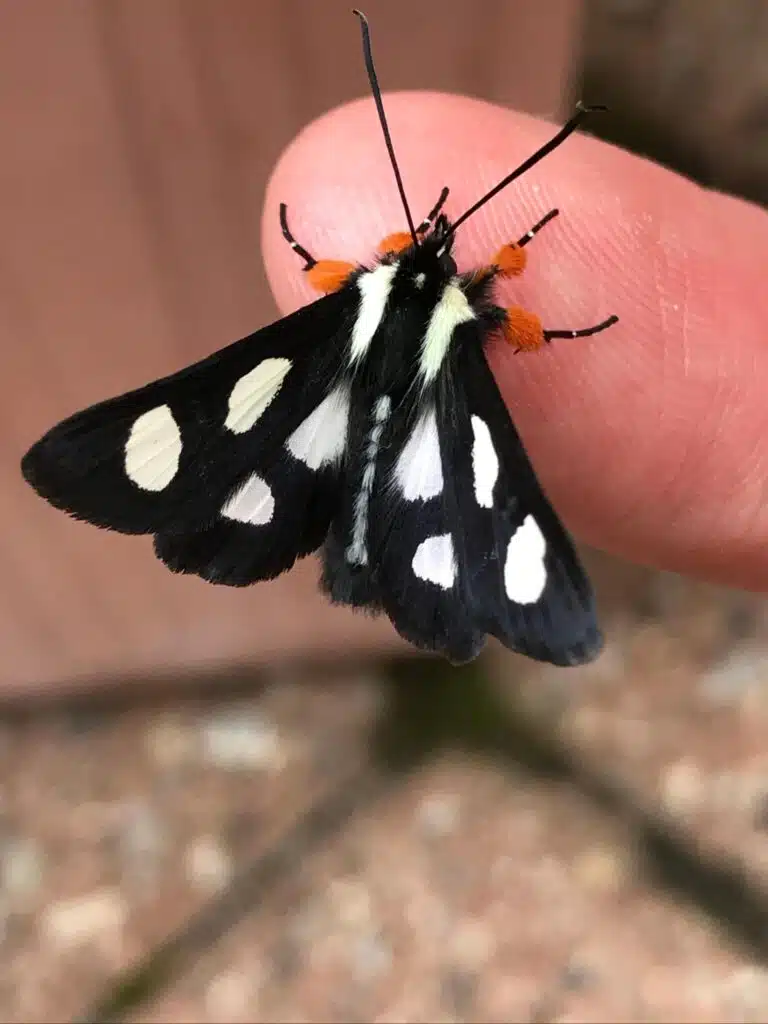
Scientific name: Alypia octomaculata
Eight-spotted Forester Moths are one of the common eastern US black moths.
Its Southern limits are Texas to the West and Florida to the East. Its range expands to The Great Lakes.
Most of its forewings and hindwings are black. This is a species that also has yellow and metallic white spots along the wings.
Much of its black coloring is also inherited from its caterpillar stages. The Eight-spotted Forester Moth caterpillar has a white body with numerous thin black bands and black dorsal spots.
Vines such as grapes tend to be the preferred host of the species.
Distribution: Eastern US states
3. Virginia Ctenucha Moth
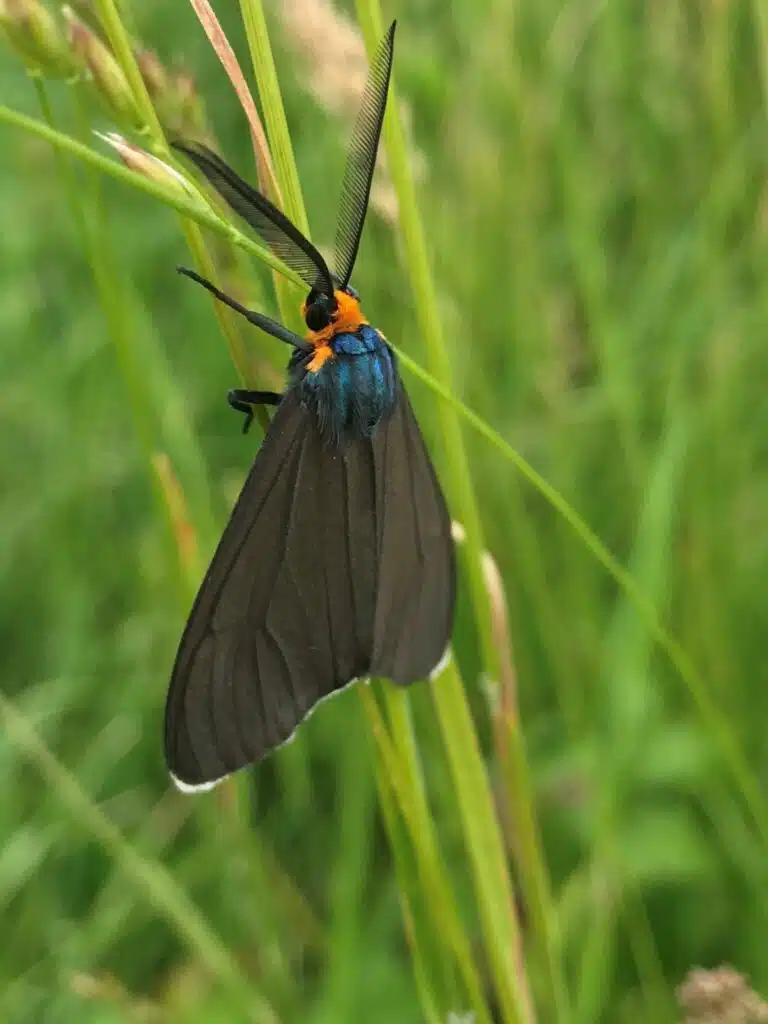
Scientific name: Ctenucha virginica
A wide distribution species in North America, Virginia Ctenucha Moth is a mostly black species.
Its uniform black color is characteristic of the species which also shows a contrasting orange head.
Some rare morphs of the moth come in olive coloring instead of black base coloring.
The caterpillar of the species is also black. It shows a hairy black body with thin yellow stripes and red lateral tufts.
Growing in numbers across the continent, this type of Black Moth is named after The state of Virginia, the Southern limit of its range.
However, the species is present further North across the US and into Canada.
Distribution: East of The Rocky Mountains
4. Grapeleaf Skeletonizer Moth
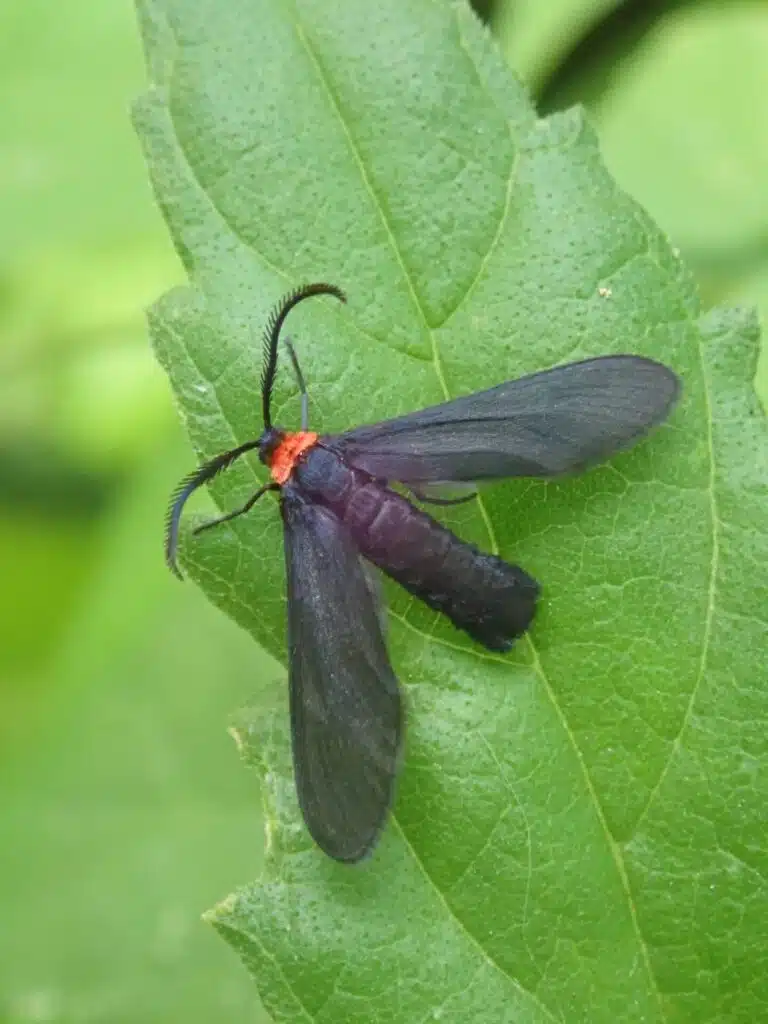
Scientific name: Harrisina americana
The Grapeleaf Skeletonizer Moth is one of the black pest moths of North America. This species has a black body and black wings.
A small orange band behind its head contrasts its dark appearance. In rare cases, the band of The Grapeleaf Skeletonizer Moth may also be yellow.
A typical pest in vineyards, the moth requires management techniques. Its caterpillars tend to feed and skeletonize the lives of vines in vineries.
Black is also seen on its caterpillars but to a lesser extent.
A mostly yellow body with black bands is specific to The Grapeleaf Skeletonizer Moth. These caterpillars don’t bite and they can be removed by hand before they start feeding on vine leaves to the point of skeletonization.
Distribution: Florida
5. Buck Moth
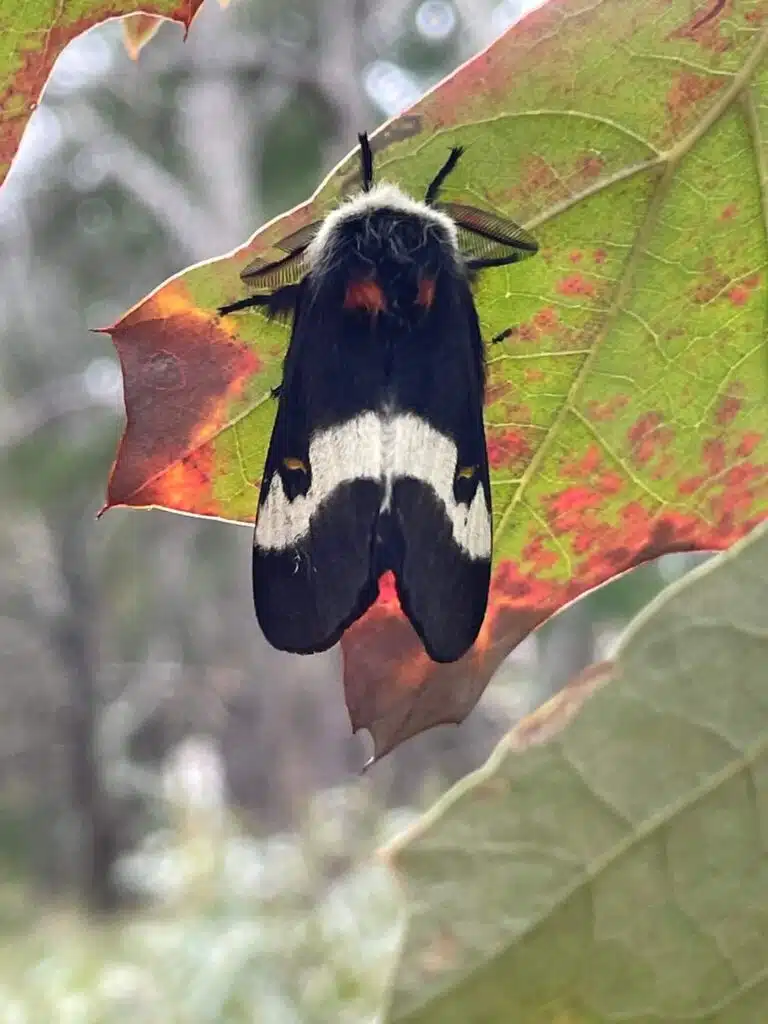
Scientific name: Hemileuca maia
A black body and black wings are specific to the female Buck Moth. Females show more black coloring across the wings compared to males which may have wider brown areas across the wings.
Both male and female Buck Moths have dark bodies with red or orange tips of the body.
The hairy body of the species may be wide, but the wingspan of the species measures anywhere between 2 and 3 inches.
Buck Moth Caterpillars are also partly black when they reach their final growth stages. Regardless of the growth stages, these caterpillars also feature numerous black spines.
Scrub oak leaves and willow leaves are the favorite foods and hosts of these caterpillars.
Distribution: The East Coast
6. Rotund Idia Moth
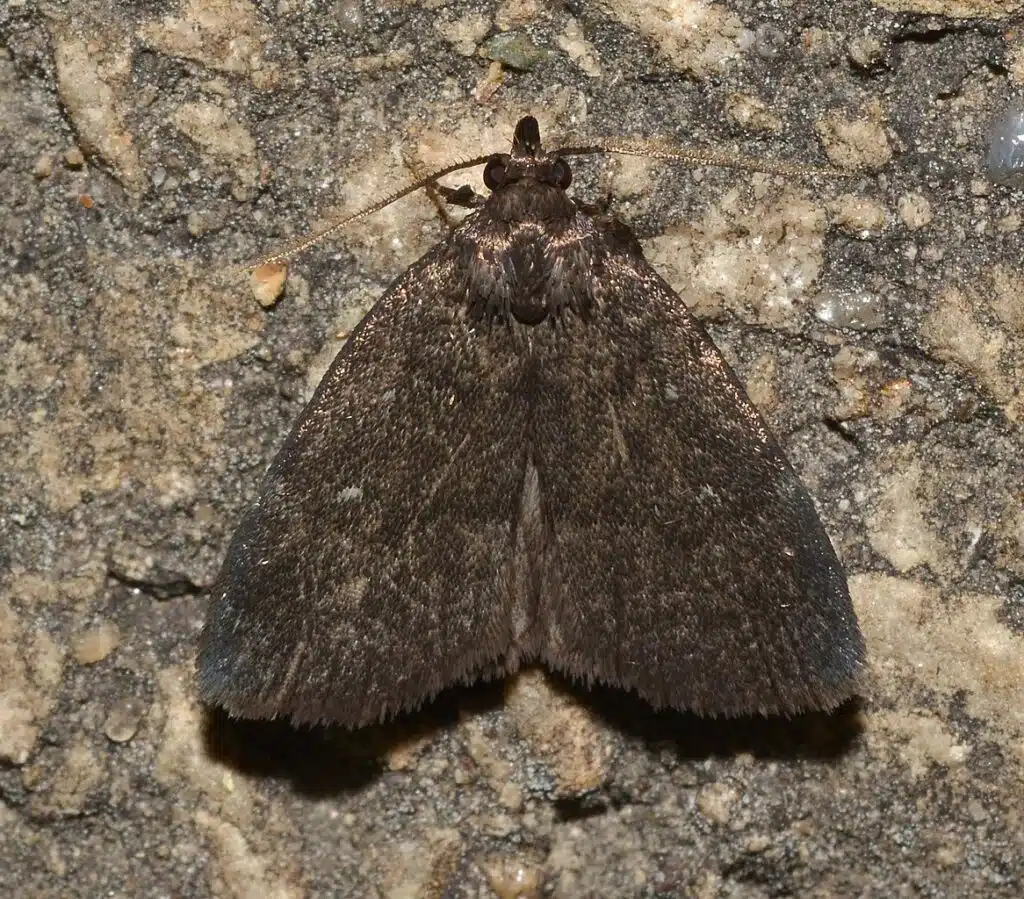
Scientific name: Idia rotundalis
Black forewings are specific to the male and female Rotund Idia Moths. This is a North American native species with widespread distribution both in The US and in Canada.
While its forewings are black, its hindwings are dark brown and dark gray.
Moths of this genus grow to a wingspan of up to 0.7 inches, being one of the smaller black moths of North America.
One or multiple Rotund Idia Moth species are seen each year. There are at least 2 broods in the Southern US states as opposed to regions of Canada where the species may only have 1 brood per year.
Coastal areas of Eastern states and their woodlands are among their preferred habitats.
Distribution: Florida to Canada
7. White-tipped Black
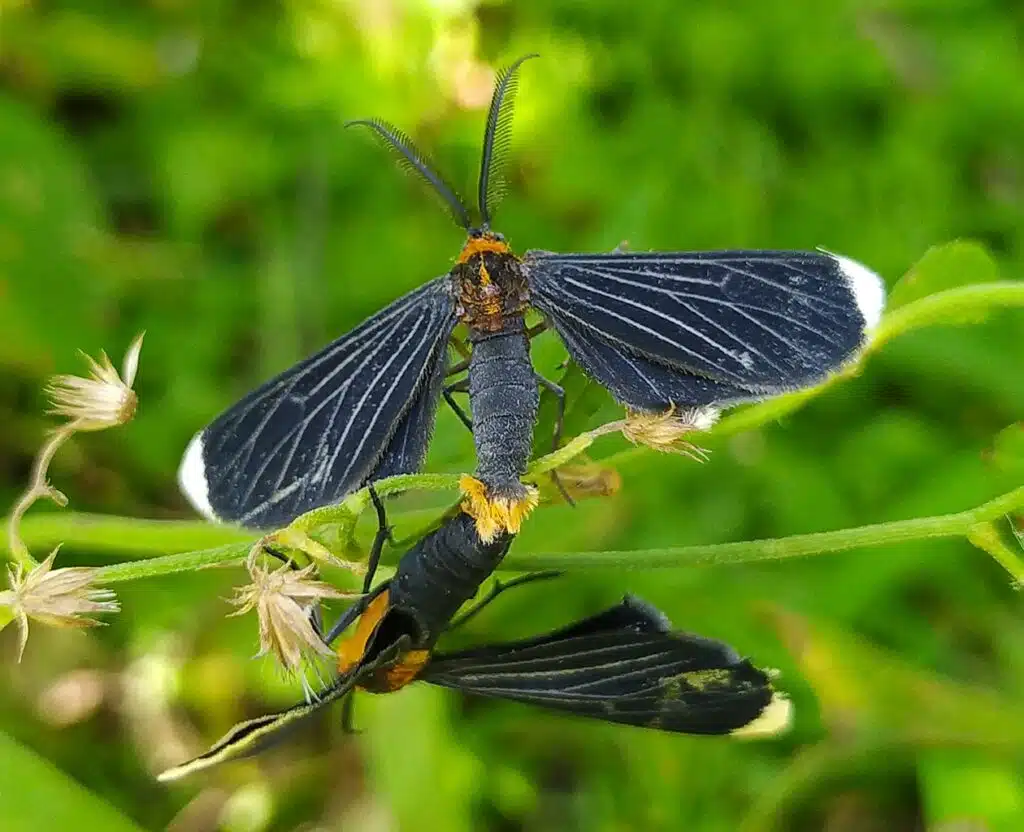
Scientific name: Melanchroia chephise
White-tipped Black Moths are mostly native to Central America and regions of Northern South America.
Small populations of the species are sometimes confirmed in Southern US states such as Texas.
Other US areas with larger White-tipped Black populations include Florida.
This species has a dark appearance with mostly black forewings. The dorsal side of its body is also black while its ventral side is orange-red.
Unlike other black moths, White-tipped Blacks also have white spots on the edges of their forewings, which inspire their name.
The species has a wingspan that measures anywhere between 1 and 1.3 inches, with the larger specimen being seen across rainforests.
Distribution: Texas to South America
8. Cinnabar Moth
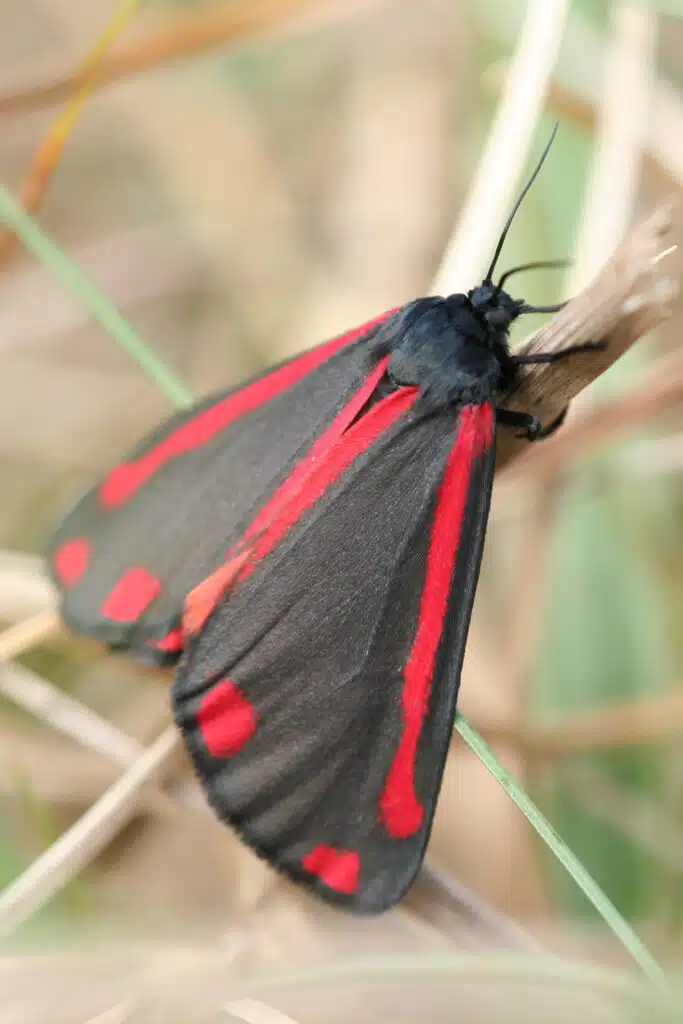
Scientific name: Tyria jacobaeae
Cinnabar Moths are among the black species with a wider presence around the world.
This species is confirmed in North America, but also in Asia and in Europe where it is mostly known for its unique red color combined with black stripes across the body and the wings.
Much of its worldwide presence is the result of the purposeful introduction of the species to control invasive asters such as ragwort.
Cinnabar Moth Caterpillars feed on invasive ragwort across various habitats.
Much of the appearance of these caterpillars is also dominated by a contrasting black and orange appearance.
The adult Cinnabar Moth can reach a wingspan of 1.7 inches while its caterpillar is known for reaching a maximum length of 1.3 inches.
Distribution: Northern Hemisphere
9. Garden Tiger Moth
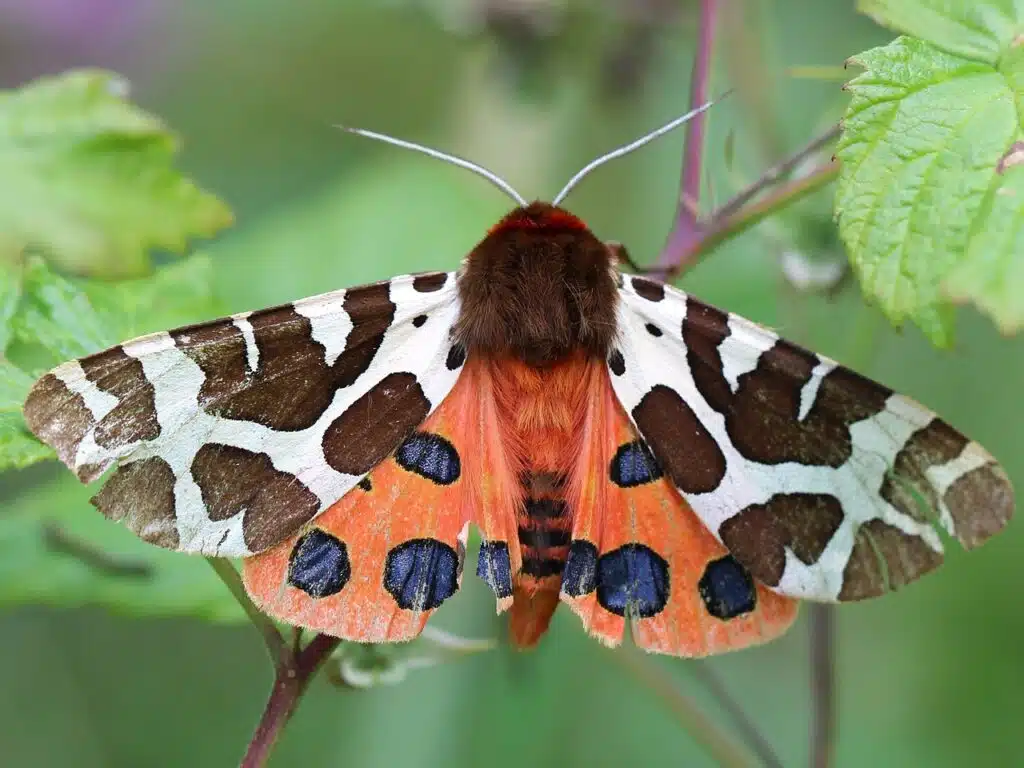
Scientific name: Arctia caja
Garden Tiger Moths are a larger moth species with considerable black sections across the wings.
Most variants of the species have brown forewings with black spots and larger black spots on the hindwings. Different other color combinations with black spots are also seen on this type of moth.
A common species around the world, this type of moth is a generalist feeder, quick to spread.
It feeds on all types of weeds, flowers, and wildflowers, such as plantago.
Adult moths of the species have a wingspan of over 2 inches and exhibit different defensive mechanisms.
A distinct capacity to spray irritating substances on potential predators is confirmed by the species.
Distribution: North America and Europe
10. Mournful Thyris Moth
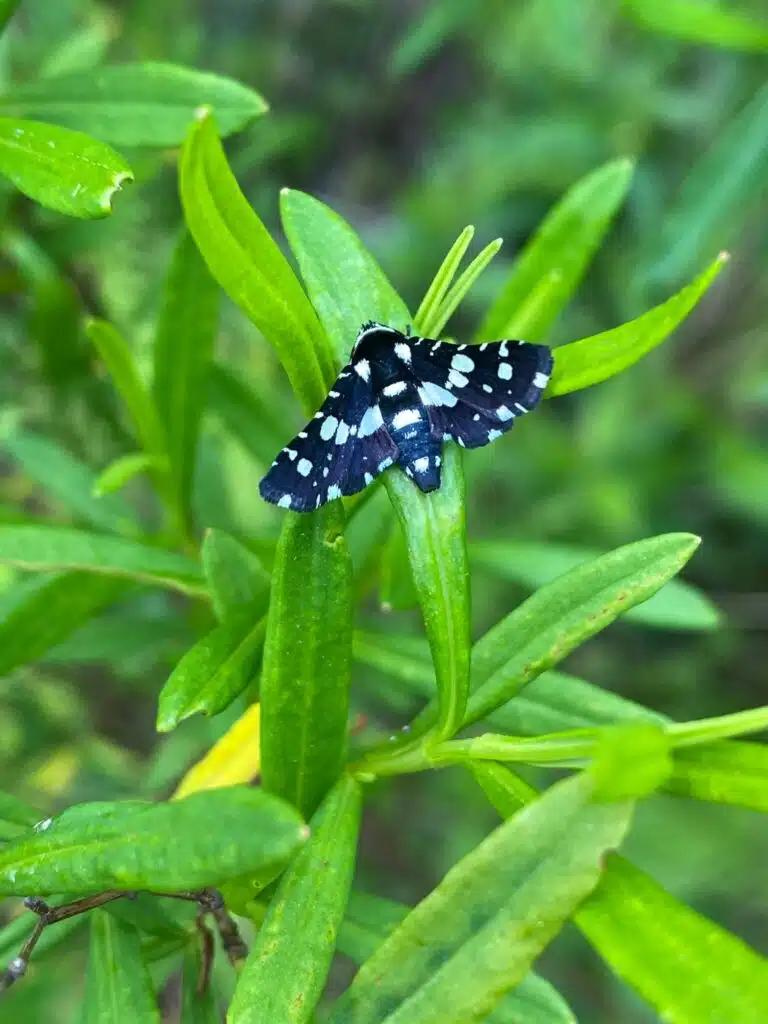
Scientific name: Pseudothyris sepulchralis
A mostly black appearance with a large white spot characterizes the appearance of The Mournful Thyris Moth.
This species lives in the Southeastern part of North America and it represents one of the smallest types of black moths in the world.
Some of the smaller Mournful Thyris Moths have a wingspan of just 0.5 inches while some of the largest moths of the species may reach a wingspan of up to 0.9 inches.
Black dominates its body which also shows a few white spots and its forewings and hindwings which also show contrasting white spots.
The caterpillars of this species eat different types of wildflower leaves. Their preferences include Mediterranean smilax and Mexican sarsaparilla.
Distribution: Eastern and Southeastern US
11. White-spotted Sable
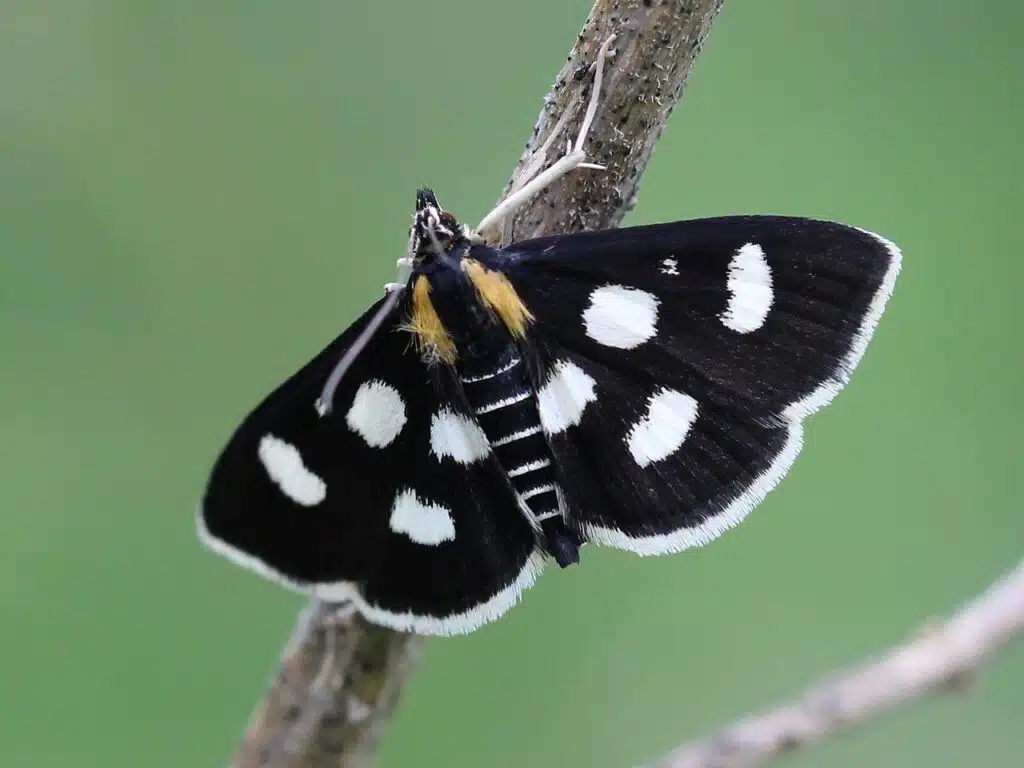
Scientific name: Anania funebris
A similar appearance to Mournful Thyris Moth is seen on The White-spotted Sable.
This species is dominated by black colors with a black body that has contrasting white bands and yellow sections around the head.
Its forewings and hindwings are mostly black with large white spots.
As the Mournful Thyris Mith, The White-spotted Sable is a species that has a short wingspan that may reach 0.9 inches.
The caterpillar of the species doesn’t show a base black color but a base green color.
Various species of goldenrod are the wildflower hosts of its green caterpillar.
Distribution: North America, Europe, and Asia
12. Joyful Virbia Moth
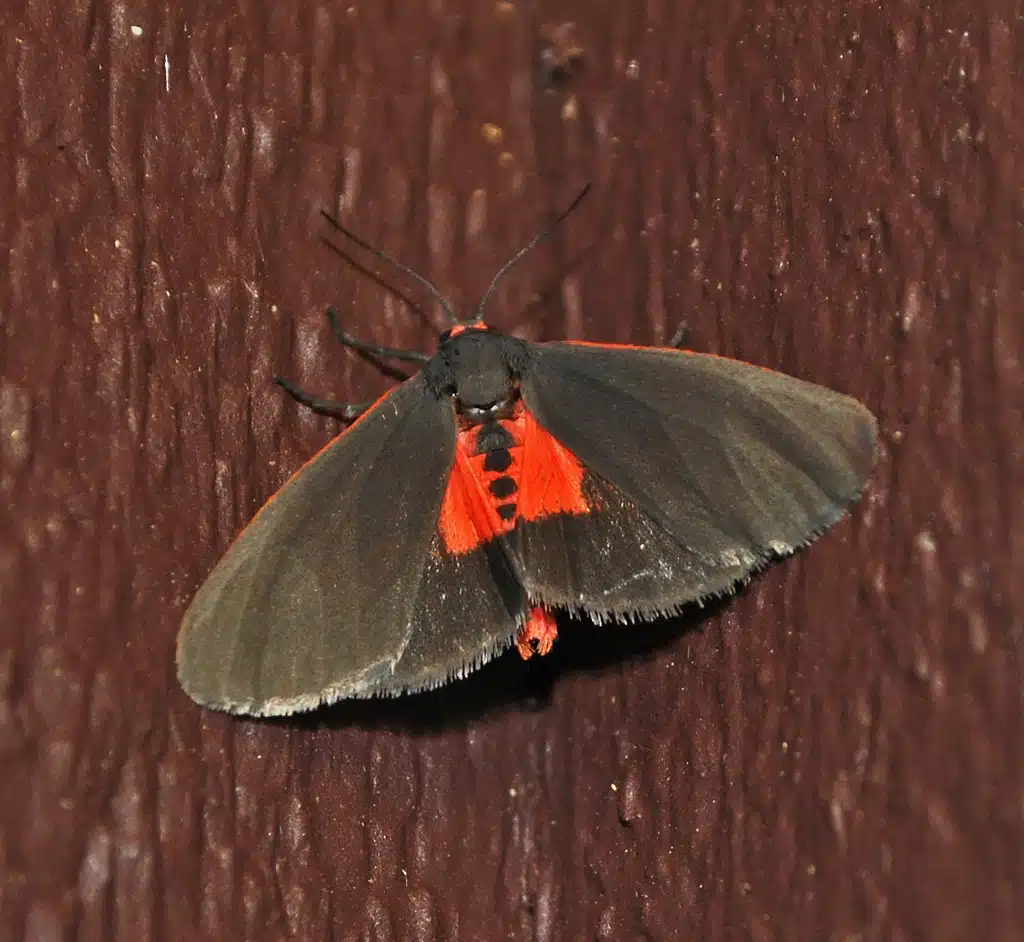
Scientific name: Virbia laeta
A mostly black appearance contrasted by red sections is specific to The Joyful Virbia Moth.
Its upper body is uniform black while its lower body is red.
This species has black forewings and black hindwings with large red sections on the inner side, closer to the body.
Joyful Virbia Moths represent a small species that may reach a maximum wingspan of 0.6 inches.
A black appearance is also specific to the late instar Joyful Virbia Moth Caterpillar. Its body is black, as are its numerous spiny hairs.
Joyful Virbia Moths are found in areas with host weeds and wildflowers such as dandelion.
Distribution: Southern and Southeastern US
13. Ocean Spray Fairy Moth
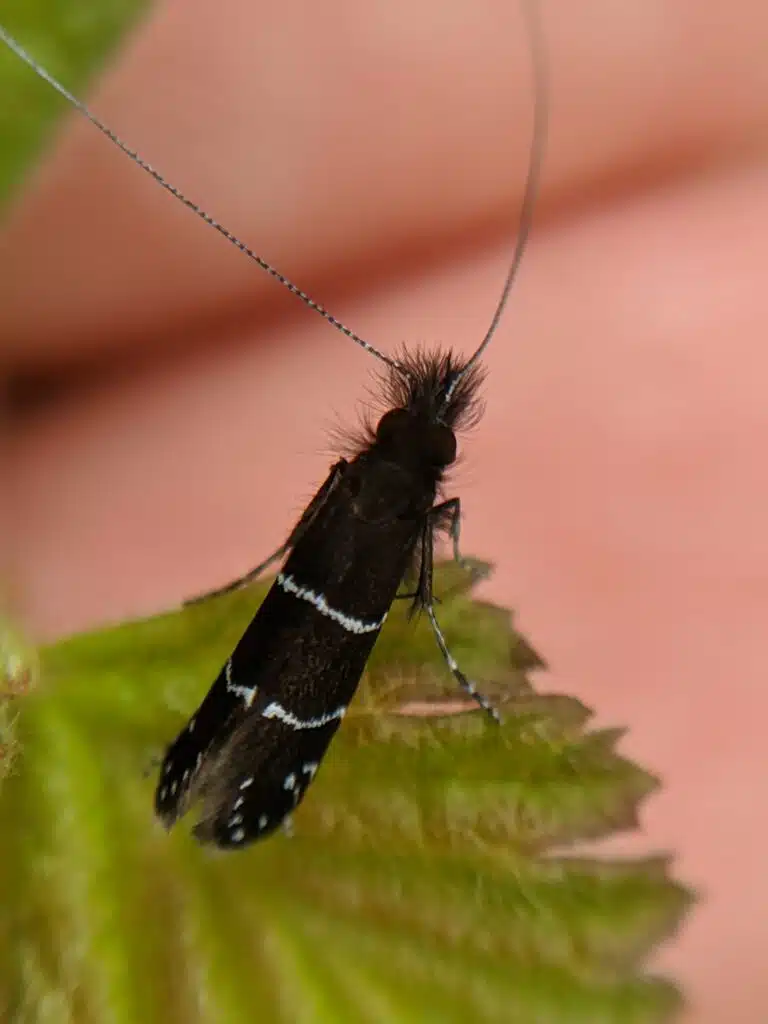
Scientific name: Adela septentrionella
A native species on The West Coast, The Ocean Spray Fairy Moth is a small black moth.
Its wingspan varies between 0.1 and 0.2 inches while its antennae can be twice the length. The moth has black forewings with a thin white contrasting band and brown hindwings.
Active from March, the species is only seen around California, mainly around a small number of wildflowers.
Cream blush wildflowers are among the most common species of wildflowers these moths feed on.
This species gets its name from its ability to spray pheromones during the mating process.
High male-to-male aggression is also tied to this pheromone among Ocean Spray Moths.
Distribution: California
14. Black Witch
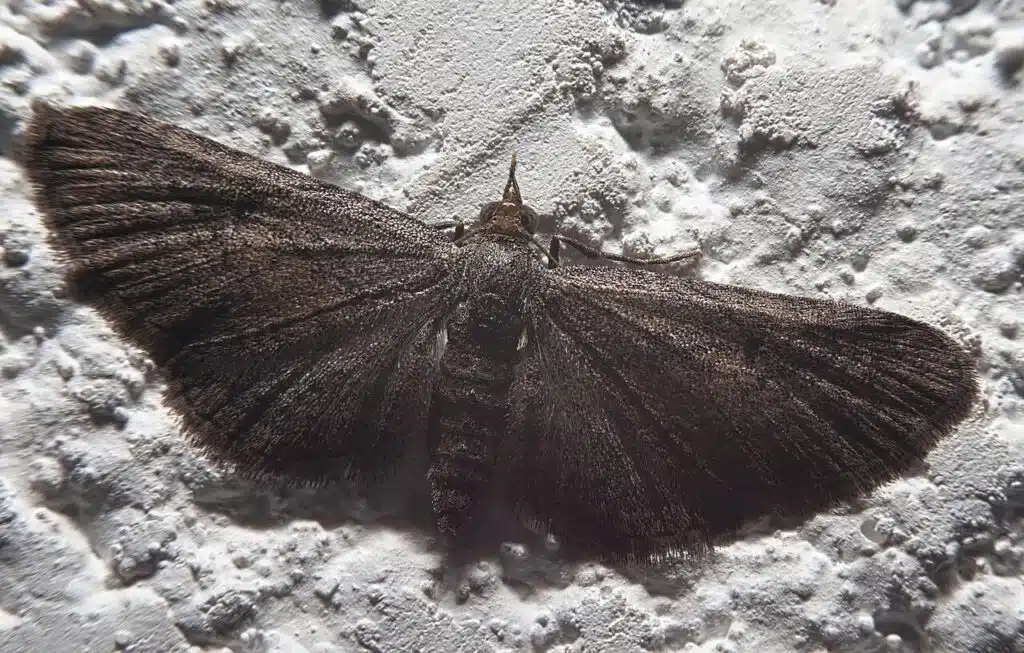
Scientific name: Ascalapha odorata
Black Witch is a large type of moth that has been recorded with a maximum wingspan of 5.9 inches.
Its coloring is dark, representing a blend of black and brown colors, together with small contrasting white areas across its wings.
Black and blue eyespots are further distinguishable on their wings.
This species has a widespread distribution from North to South America, with high populations across the US.
Moths of this family are seen throughout the year in Southern states and from summer to fall in other areas of The United States.
Its larvae are seen on specific hosts and wildflowers. Cassia wildflowers are among its favorites.
Adults move on to other types of food which include tree sap.
The name of the species comes from popular folklore where spotting this moth is a bad sign.
Regions of Central America are among the first to name the species as a sign of a possible death in the family.
Distribution: The Americas
15. Chimney-Sweeper
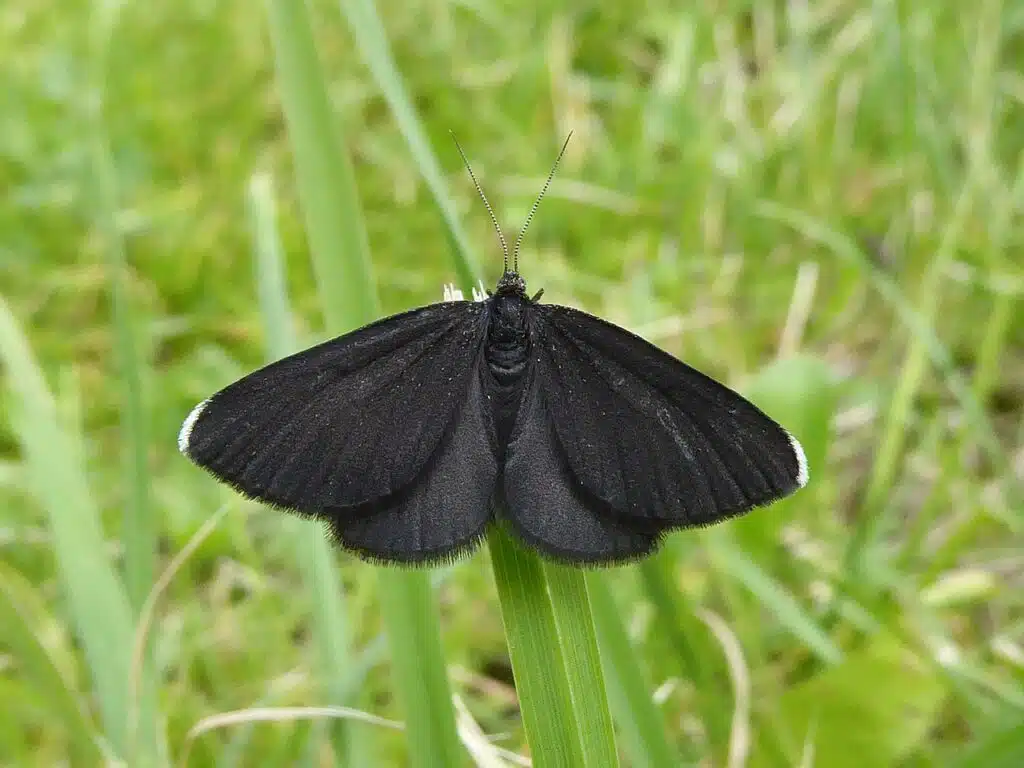
Scientific name: Odezia atrata
A rare black moth in most of Europe, The Chimney-Sweeper is still found in high numbers in Southern and Western parts of the continent.
This species has an almost all-black appearance, with tiny gradient white dots on the upper part of its forewings.
White bands are also specific to the margins of its upper wings while its body is also black with tiny white dots.
Some variations exist in this species. Rare Chimney-Sweeper populations can have tiny white-brown spits across the wings and their body, mostly those that live at a higher elevation.
Chimney-Sweepers are among the species that grow to a maximum wingspan of 1 inch.
They are active at night and are only known to feed on a selected number of wildflowers such as those in the celery family.
Distribution: Western Europe
16. Australian Magpie Moth

Scientific name: Nyctemera amicus
Australian Magpie Moths are one of Oceania’s black moths. This is a black species with black forewings and a black body.
Its wings have a V-shaped white band while an orange collar is present around the neck.
Long dark brown or black feathery antennae are also specific to this species of moths.
Both the adult and the caterpillar absorb the toxins of their host plants to make themselves unpalatable to predators.
The Australia Magpie Moth Caterpillar is also black.
It exhibits orange or brown spots along the body with additional scarce black hairs.
Both the caterpillar and the adult moth are poisonous to some of their smallest predators.
Distribution: Oceania
17. Red-necked Footman
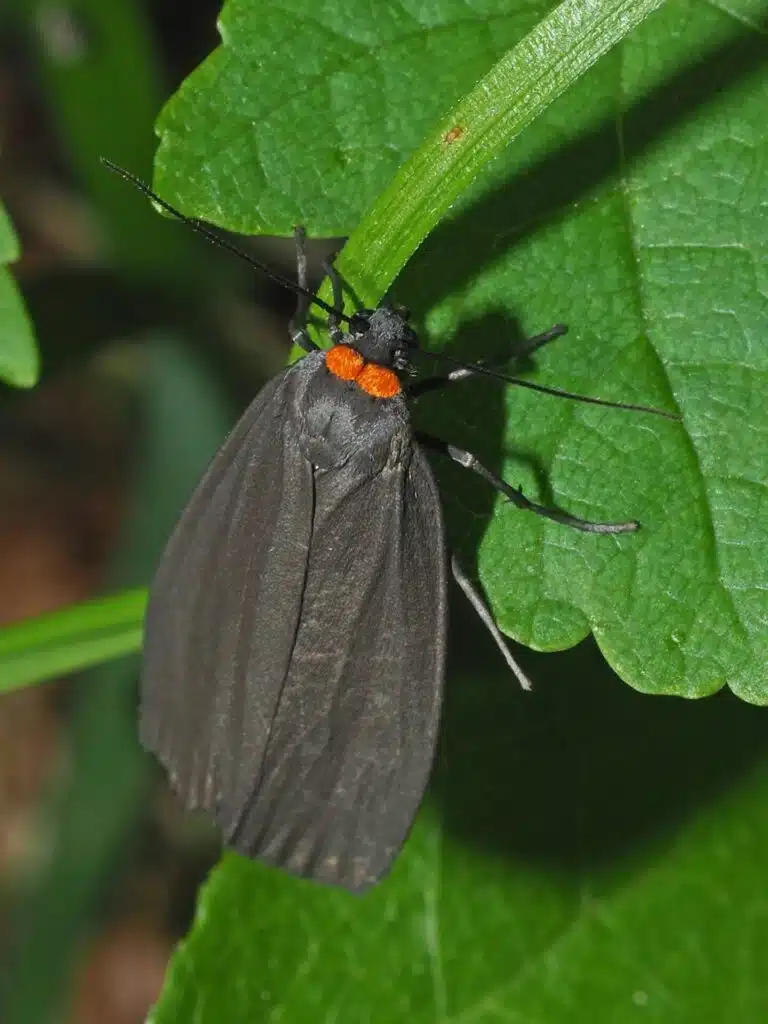
Scientific name: Atolmis rubricollis
This type of black moth is named after its neckband. This is an orange, brown, or red neckband that contrasts its black head, black, body, and black wings.
Uniform black coloring is specific to the Red-necked Footman, a black moth with a high European presence and a confirmed status in North America.
The species can be spotted during the summer around woodlands. As a nocturnal moth, it prefers to rest during the day, wrapping its wings around its body.
This species is found in different types of mixed woodlands, especially in coastal areas.
Red-necked Footmans living inland may have a brown-dominant nuance.
Spotted up until October, the moth has a diverse diet based on Pincushion flowers and wildflowers of a similar species.
Its caterpillars have a different diet, preferring to eat lichen. Red-necked Footman Caterpillars are seen on the tree part that isn’t exposed to sunlight, more likely to grow lichen.
Distribution: Europe and North America
18. Black Zale Moth
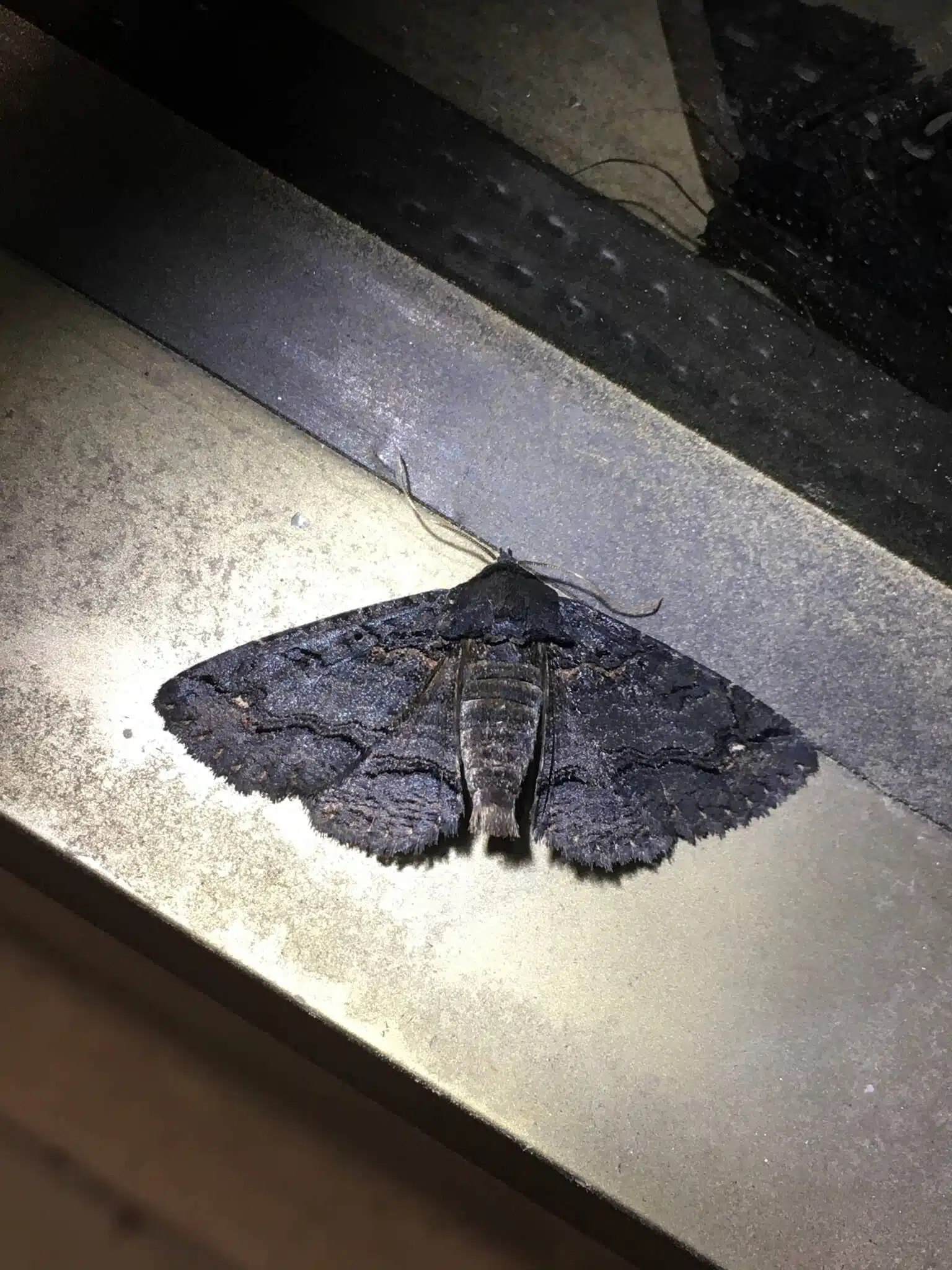
Scientific name: Zale undularis
Black and brown colors are seen along the wings and on the body of The Black Zale Moth.
Moths of this species take on the appearance of dark tree bark to camouflage themselves during the day.
The ventral color of the species is a combination of brown and gray, with only a few black mottled marks.
They live in the Northeastern parts of The United States and the Northern states from Maine to Minnesota.
Smaller populations of Black Zale Moths are also found in the Southeastern Canadian provinces.
This species of moth grows to an average wingspan between 1 and 2 inches.
Distribution: Northeastern US states
19. White-striped Black
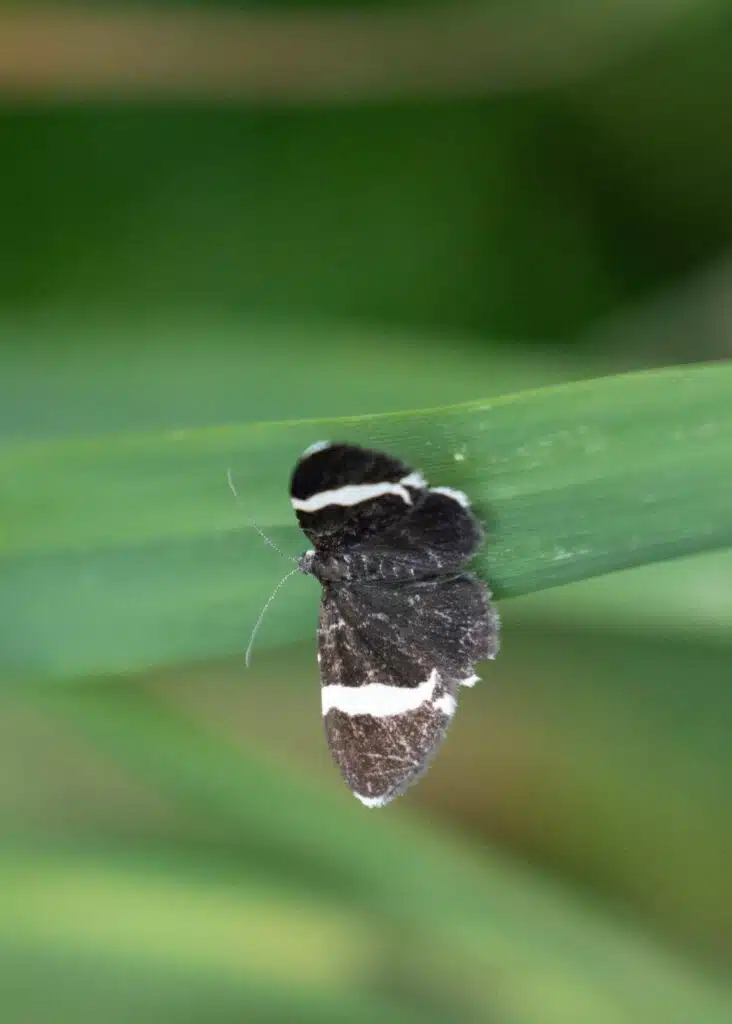
Scientific name: Trichodezia albovittata
Black dominates the appearance of The White-striped Black Moth. This species has a black body, black forewings, and black hindwings.
As its name implies, the moth also has bright white bands across the forewings and the hindwings.
The antennae of the moth are mostly black with faint white bands.
Widespread around North America up to Alaska, this adaptable species grows to a maximum wingspan of around 2 inches.
Some of the earliest White-striped Black moths are seen in April.
These types of moths also play an important role in the ecosystem as they can feed on various weeds.
The White-striped Black Caterpillar feeds on Jewelweeds.
Distribution: North America
20. Waved Black
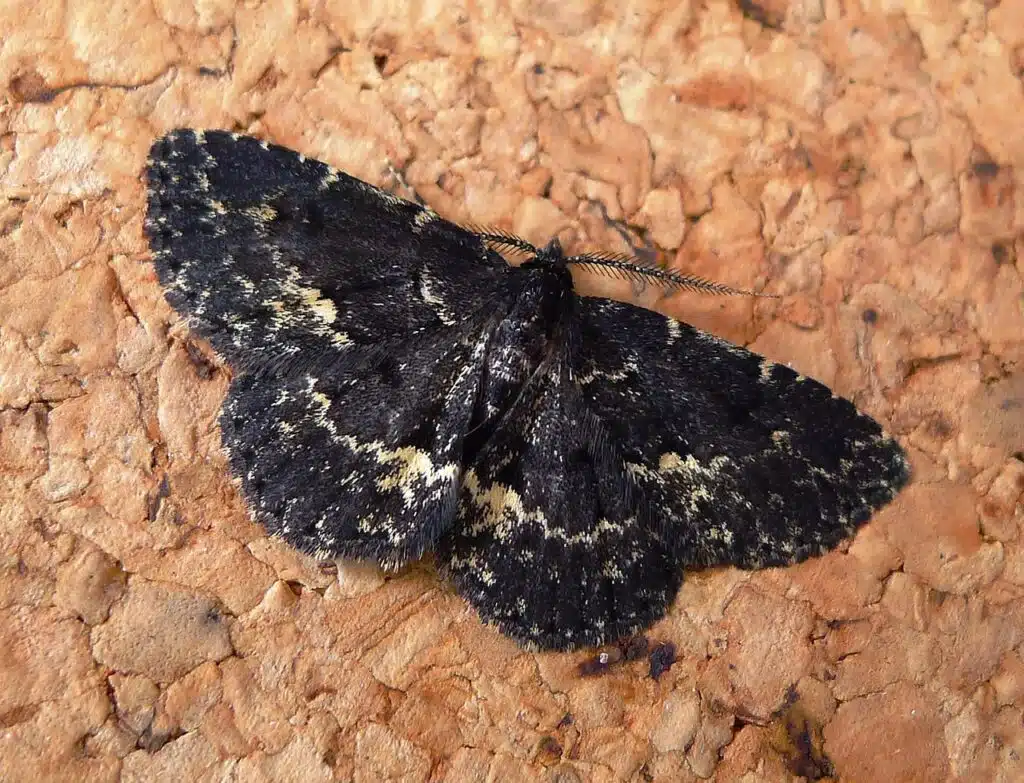
Scientific name: Parascotia fuliginaria
A black appearance with a white line is seen on the wings of the Waved Black. These white lines have a wavy appearance which is where the name of the moth comes from.
Waved Black moths reach a wingspan of up to 1.1 inches, being slightly smaller than other types of black moths in Asia and Europe.
Still, Waved Black Moths are found all around the world. They are seen in Asia and also confirmed in North America. Temperate climates around the Northern Hemisphere can house this species.
Active during the summer, this species may show a slightly different season depending on its location.
Some of the ideal locations for the species include parks and woodlands.
It’s here that the moth finds suitable hosts and food for its caterpillars. The Waved Black caterpillar eats foods such as fungi growing on birch. As a result, it can be found in birch woodlands.
Distribution: Northern Hemisphere
21. Black Turnip Moth
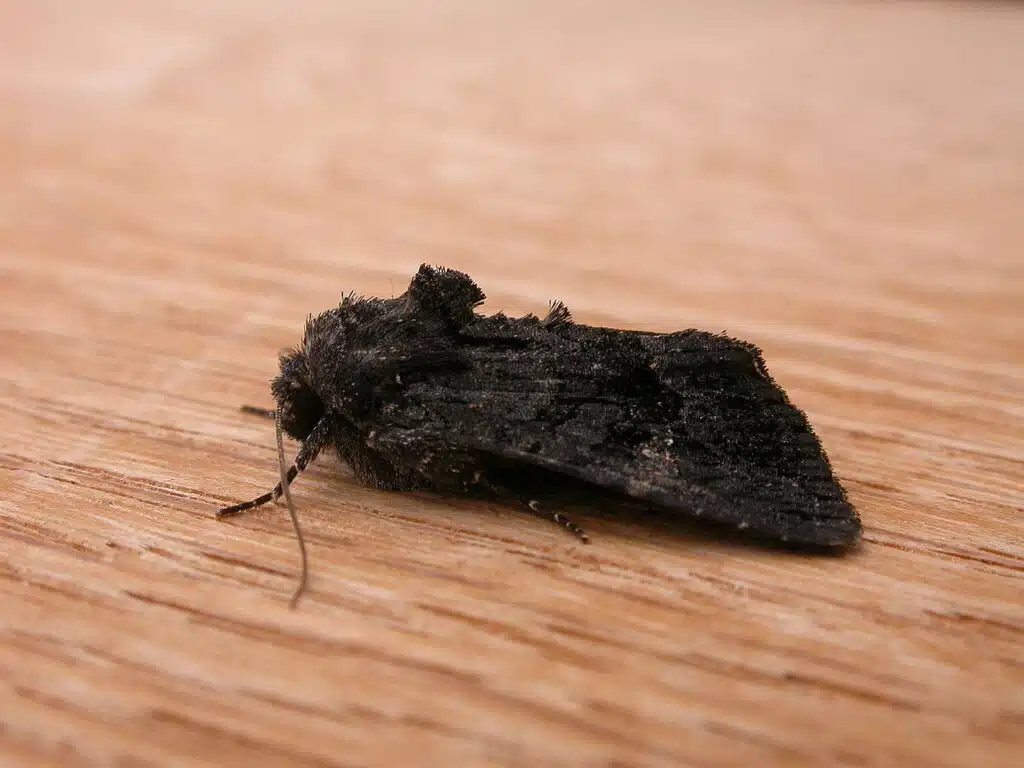
Scientific name: Neumichtis nigerrima
Black Turnip Moths are among the largest types of black moths in the world. This is a species native to Australia.
Found both in Eastern and Western Australia, Black Turnip Moths grow to a wingspan of almost 2 inches.
These types of moths are known to have a lighter brown ventral color, which is rarely seen.
The caterpillars of the species have a bright green appearance with a black head.
Grasses, wildflowers, and different types of plants serve as hosts for The Black Turnip Moth.
This species feeds on various grasses, beet, potatoes, and clovers, as well as on almost all types of wild mint.
A type of pest, this moth and its caterpillars require management techniques. Covering plants in gardens might be one of the small-scale preventive measures against the species.
Distribution: Australia
22. Black Shawl Moth
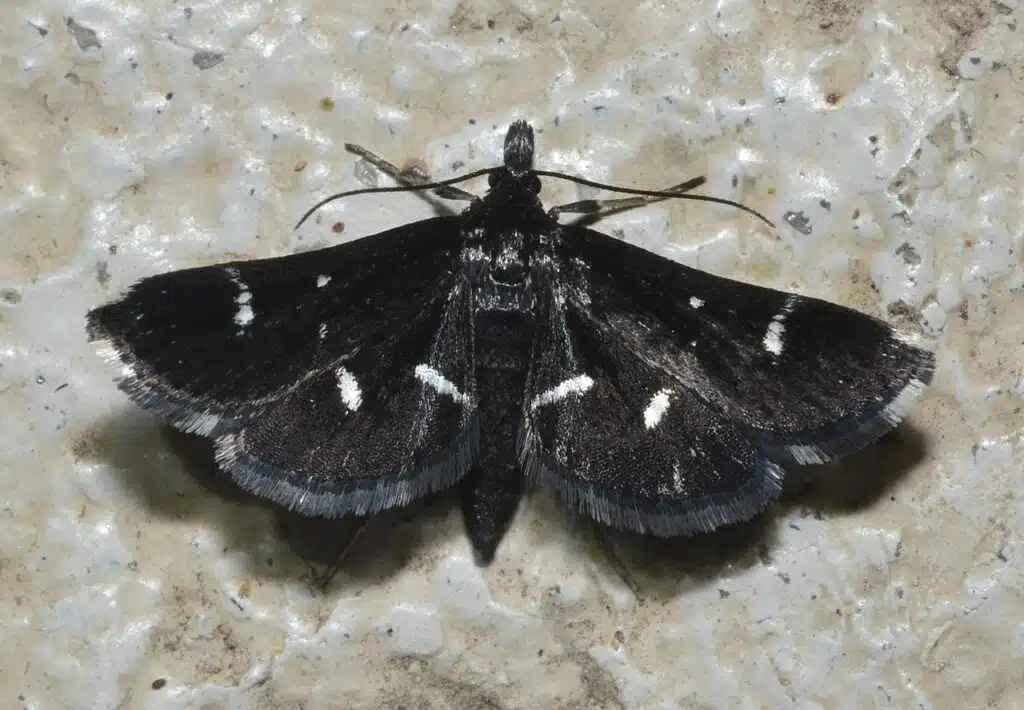
Scientific name: Diasemiodes nigralis
Mostly black color is specific to The Black Shawl Moth. It represents one of the multiple moths with wave-shaped white marks along its wings.
The Black Shawl Moth is found across the Eastern United States. Living in coastal regions but also in woodlands further inland, this species also has a black body with fewer white marks compared to similar black moths.
Very long antennae are also specific to the male Black Shawl Moth. This species has antennae as long as its body.
The wingspan of the species is variable. Most Black Shawl Moths have a wingspan between 1 and 2 inches.
Distribution: Eastern North America